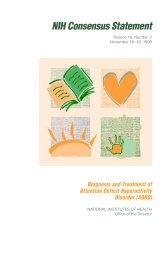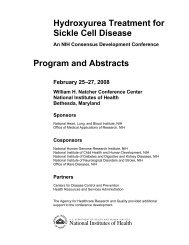Overview and Pathogenesis of <strong>Celiac</strong> <strong>Disease</strong>Martin F. Kagnoff, M.D.<strong>Celiac</strong> disease (CD) is characterized by small intestinal mucosal inflammation andmucosal injury. <strong>Disease</strong> is seen in genetically susceptible individuals following enteric encounterwith proteins in wheat, rye, and barley and often is accompanied by nutrient malabsorption.Mucosal damage, which is most marked in the proximal small intestine, is characterized by aspectrum of pathology that ranges from minimal to complete villous atrophy, an increasedinfiltrate of lymphocytes and plasma cell infiltrate in the lamina propria, increased numbers ofintraepithelial lymphocytes, and varying degrees of crypt hyperplasia accompanied by increasedcrypt mitoses.CD was once considered a rare disorder in the U.S., occurring in as few as 1/10,000.However, with the advent and broader application of antibody tests as a screening tool over thepast decade, it has been recognized to be far more common. Indeed, the prevalence of CD in theUnited States and in Europe appears to be in the range of 1:250 to 1:150, with increasingnumbers of studies supporting the latter estimate. (1,2) Concurrently, the presenting clinical pictureof CD has changed. The former classic “textbook description,” in which patients with CDpresented with marked diarrhea, steatorrhea, and weight loss, is now overshadowed by the morefrequent presentation with one or more complaints such as abdominal bloating, lethargy, a lackof energy, irritability or depression, menstrual abnormalities, growth disturbances in children, orneurological complaints compatible with peripheral neuropathy. In some patients, the onlylaboratory abnormalities may be evidence of iron deficiency or osteopenia.The pathogenesis of CD involves environmental, genetic, and immunologic factors. (3) Forclarity of defining key factors in disease pathogenesis, the events contributing to thepathogenesis of CD can be viewed as luminal events and events that occur in the intestinalmucosa, including the eventual activation of immune cells and ensuing tissue damage. The keyenvironmental factor known to be essential for the development of CD is enteric exposure tocertain proline and glutamine rich proteins in the dietary grains wheat, rye, and barley. Oftensimply referred to as “gluten,” the actual proteins that can activate disease are the gliadins and, toa lesser extent, glutenins (4,5) in wheat, the hordeins in barley, and the secalins in rye. Peptides inthese proline rich proteins are poorly digested into free amino acids or very small peptides (i.e.,di, tri, and tetrapeptides) by pancreatic and intestinal brush border proteases in the humanintestine. (6,7) Current models of disease envision that the larger remaining peptides ultimately leadto the activation of disease-associated mucosal T-cells. The latter is more efficient when thosepeptides are acted on by tissue transglutaminase to yield more negatively-charged peptides,which are more efficient in activating disease relevant T-cells and T-cell-mediated immuneresponses in genetically susceptible individuals.What are the relevant genes that contribute to susceptibility to CD? It is known that geneswithin the HLA class II DQ subregion on chromosome 6 are necessary, but not sufficient, todevelop CD. Approximately 95 percent of patients with CD have a DQ2 heterodimer comprisedof DQB1*02 and DQA1*05 and most of the remaining 5 percent have a DQ8 heterodimercomprised of DQB1*0302 and DQA1*03. (8,9) A small number of individuals lacking either ofthose heterodimers have either DQB1*02 or DQA1*05 alone. (10) Gene dosage also affects CD19
susceptibility (e.g., DR17 homozygous individuals who carry DQB1*02 and DQA1*05 in cis onboth chromosomes have a greater risk of disease). (11) CD is concordant in approximately70 percent of monozygotic twin pairs and approximately 30–40 percent of HLA identicalsiblings, and it has been estimated that HLA class II genes are responsible for about 40 percentof the genetic contribution to disease. (12) There is no clear definition of what other genescontribute to disease or how they do so, although linkage studies suggest disease-associatedgenes in a region of chromosome 5 and perhaps a region on chromosome 19 in somepopulations. (13)What is the link between the DQ2 and DQ8 heterodimer, the disease activating peptidesand T-cell-activated immune injury. CD4 + T-cell populations that recognize putative diseaseactivating peptides are present in the intestinal mucosa of CD patients. Moreover, these peptidesbind more efficiently in the peptide binding groove of the DQ2 or DQ8 heterodimer whenspecific glutamine residues are deamidated to negatively-charged glutamic acid by tissuetransglutaminase. (14,15) Nonetheless, a broad array of peptides derived from gliadins, glutenins,hordeins, and secalins likely can activate disease (16,17) and their deamidation does not appear to bean absolute requirement, at least for initiating this disease. (17)In summary, significant progress has been made at the protein, genetic and immunologiclevel in understanding the pathogenesis of CD. However, significant questions have not beenanswered and a great deal remains to be discovered regarding early luminal events that effectdisease susceptibility and pathogenesis, the more complex and perhaps subtle genetic factors andmechanisms that enhance disease susceptibility, and the pathways involved in the mucosal entryand processing of disease activating peptides and the activation of T-cells and other cells thatlead to the immune tissue injury.References1. Hoffenberg EJ, MacKenzie T, Barriga KJ, et al. A prospective study of the incidence ofchildhood celiac disease. J Pediatr. 2003;143:308–314.2. Maki M, Mustalahti K, Kokkonen J, et al. Prevalence of <strong>Celiac</strong> disease among children inFinland. N Engl J Med. 2003;348:2517–2524.3. Kagnoff MF. <strong>Celiac</strong> disease pathogenesis: the plot thickens. Gastroenterology.2002;123:939–943.4. Van de Wal Y, Kooy YM, Van Veelen P, et al. Glutenin is involved in the gluten-drivenmucosal T cell response. Eur J Immunol. 1999;29:3133–3139.5. Molberg O, Solheim Flaete N, Jensen T, et al. Intestinal T-cell responses to highmolecular-weightglutenins in celiac disease. Gastroenterology. 2003;125:337–344.6. Hausch F, Shan L, Santiago NA, Gray GM, Khosla C. Intestinal digestive resistance ofimmunodominant gliadin peptides. Am J Physiol Gastrointest Liver Physiol.2002;283:G996–G1003.20
- Page 1 and 2: NIH Consensus Development Conferenc
- Page 3 and 4: III. What Are the Manifestations an
- Page 5 and 6: • What is the management of celia
- Page 7 and 8: Monday, June 28, 2004 (continued)I.
- Page 9 and 10: Monday, June 28, 2004 (continued)II
- Page 11 and 12: Wednesday, June 30, 2004 (continued
- Page 13 and 14: Lisa H. RichardsonConsumer Represen
- Page 15 and 16: Ciaran P. Kelly, M.D.Director, Celi
- Page 17 and 18: Van S. Hubbard, M.D., Ph.D.Director
- Page 19: AbstractsThe following are abstract
- Page 23 and 24: The Pathology of Celiac DiseaseDavi
- Page 25 and 26: In this regard, the transport pathw
- Page 27 and 28: for the IgG-based test, while speci
- Page 29 and 30: 15. de Lecea A, Ribes-Koninckx C, P
- Page 31 and 32: Clinical Algorithm in Celiac Diseas
- Page 33 and 34: Considera diagnosisof celiac diseas
- Page 35 and 36: There are populations at particular
- Page 37 and 38: Serological Testing for Celiac Dise
- Page 39 and 40: Estimates of the sensitivity of the
- Page 41 and 42: the risk and severity of CD may als
- Page 43 and 44: What Are the Prevalence and Inciden
- Page 45 and 46: ascribed to excess menstrual loss.
- Page 47 and 48: ReferencesFamily History of Celiac
- Page 49 and 50: Carroccio A, Iannitto E, Cavataio F
- Page 51 and 52: identified by surveys or through so
- Page 53 and 54: Clinical Presentation of Celiac Dis
- Page 55 and 56: een widely reported. The question r
- Page 57 and 58: The Many Faces of Celiac Disease: C
- Page 59 and 60: References1. Green PH, Jabri B. Coe
- Page 61 and 62: Association of Celiac Disease and G
- Page 63 and 64: Does the Gluten-Free Diet Protect F
- Page 65 and 66: Skin Manifestations of Celiac Disea
- Page 67 and 68: allow a better understanding of the
- Page 69 and 70: 4. Henriksson KG, Hallert C, Walan
- Page 71 and 72:
characterized, clinically-identifie
- Page 73 and 74:
10. Hoffenberg EJ, Emery LM, Barrig
- Page 75 and 76:
ataxia, epilepsy with posterior cer
- Page 77 and 78:
Consequences of Testing for Celiac
- Page 79 and 80:
Osteoporosis/FracturesThere were 11
- Page 81 and 82:
Dietary Guidelines for Celiac Disea
- Page 85 and 86:
21. Thompson T. Thiamin, riboflavin
- Page 88 and 89:
In order to effectively counsel ind
- Page 90 and 91:
9. Hallert C, Granno C, Hulten S, M
- Page 92 and 93:
adhered to the GFD after more than
- Page 94 and 95:
Patient education, close supervisio
- Page 96:
26. Mustalahti K, Lohiniemi S, Laip







